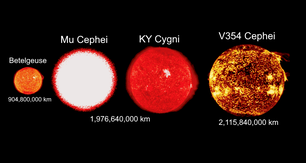Emily Levesque
Emily Levesque is an American astronomer and assistant professor in the Department of Astronomy at the University of Washington.[1] She is renowned for her work on massive stars and using these stars to investigate galaxy formation. In 2014, she received the Annie Jump Cannon award for her innovative work on gamma ray bursts.[2] and the Sloan Fellowship in 2017[3] In 2015, Levesque, Rachel Bezanson, and Grant R. Tremblay published an influential[4] paper,[5] which critiqued the use of the Physics GRE as an admissions cutoff criterion for astronomy postgraduate programs by showing there was no statistical correlation between applicant's score and later success in their academic careers. Subsequently, the American Astronomical Society adopted the stance that the Physics GRE should not be mandatory for graduate school applications,[6][7] and many graduate astronomy programs have since removed the Physics GRE as a required part of their graduate school applications.[4][7]
Emily Levesque | |
|---|---|
| Born | Taunton, Massachusetts, U.S. |
| Alma mater | MIT University of Hawaii |
| Occupation | Assistant Professor at University of Washington[1] |
| Website | http://www.emlevesque.com |
Early life and education
Levesque grew up in Taunton, Massachusetts.[8] She received her undergraduate degree in physics at MIT in 2006, followed by a PhD in astronomy at the University of Hawaii in 2010.[9]
Academic career
From 2010 to 2015, Levesque was a Post Doc at University of Colorado as an Einstein Fellowship from 2010 to 2013, and then followed by a Hubble Fellowship from 2013 to 2015.[10][11] She has been an assistant professor in the Department of Astronomy at the University of Washington since 2015.[1]
Research

Levesque uses both observations and modeling in her work. In the ultraviolet portion of the spectrum, she uses the Hubble Space Telescope to obtain spectra of star-forming galaxies.[13] In the optical, she uses the Gemini and Keck observatories on Mauna Kea and the Las Campanas Observatories in Chile to study red supergiants in the Milky Way and in the Magellanic Clouds. She has discovered many new red supergiants, as well as the first candidate for a Thorne-Zytkow object (HV 2112).[14]
Levesque and Jamie Lomax also sparked a jumping spider Twitter arachnoastronomy phenomenon with the help of Nathan Morehouse who studies spider eyesight at the University of Cincinnati.[15][16]
References
- "University of Washington Department of Astronomy: Emily Levesque". depts.washington.edu. Retrieved 2016-06-15.
- "American Astronomical Society: Annie Jump Cannon Award in Astronomy". aas.org. Retrieved 2016-06-15.
- "2017 Sloan Fellowships". Archived from the original on 2017-07-08. Retrieved 2017-03-30.
- "The impact of the Physics GRE in astronomy graduate admissions". astrobites. 2016-09-09. Retrieved 2017-03-30.
- Levesque, Emily M.; Bezanson, Rachel; Tremblay, Grant R. (2015-12-10). "Physics GRE Scores of Prize Postdoctoral Fellows in Astronomy". arXiv:1512.03709 [physics.ed-ph].
- "President's Column: Rethinking the Role of the GRE | American Astronomical Society". aas.org. Retrieved 2017-03-30.
- "Some Astronomy programs dropping Physics GRE requirement – Physics GRE Discussion Forums". www.physicsgre.com. Retrieved 2017-03-30.
- "Faculty Spotlight: Emily Levesque". Retrieved 2016-06-15.
- "Levesque, Emily – Department of Astronomy". Retrieved 2016-06-15.
- "Listing of all Hubble Fellows 1990–2016". Retrieved 2016-06-15.
- "Einstein, Chandra, and Fermi Fellows". Retrieved 2016-06-15.
- Levesque, Emily M.; Massey, Philip; Olsen, K. A. G.; Plez, Bertrand; Josselin, Eric; Maeder, Andre; Georges Meynet (2005). "The Effective Temperature Scale of Galactic Red Supergiants: Cool, but Not as Cool as We Thought". The Astrophysical Journal. 628 (2): 973. arXiv:astro-ph/0504337. Bibcode:2005ApJ...628..973L. doi:10.1086/430901. ISSN 0004-637X.
- Zetterlund, Erika; Levesque, Emily M.; Leitherer, Claus; Danforth, Charles W. (2015-01-01). "Ultraviolet ISM Diagnostics for Star-forming Galaxies. I. Tracers of Metallicity and Extinction". The Astrophysical Journal. 805 (2): 151. arXiv:1504.00011. Bibcode:2015ApJ...805..151Z. doi:10.1088/0004-637X/805/2/151. ISSN 0004-637X.
- Levesque, Emily M.; Massey, Philip; Żytkow, Anna N.; Morrell, Nidia (2014-09-01). "Discovery of a Thorne–Żytkow object candidate in the Small Magellanic Cloud". Monthly Notices of the Royal Astronomical Society: Letters. 443 (1): L94–L98. arXiv:1406.0001. Bibcode:2014MNRAS.443L..94L. doi:10.1093/mnrasl/slu080. ISSN 1745-3925.
- Yong, Ed. "Tiny Jumping Spiders Can See the Moon". The Atlantic. Retrieved 2017-06-07.
- "We've Learned Jumping Spiders Can See the Moon, Thanks to Twitter". June 7, 2017. Retrieved 2017-06-09.